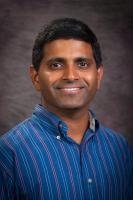NSF REU at K-State: Interactions of Matter, Light and Learning
The K-State REU program offers summer fellowships to do world-class research in our friendly physics department in the scenic Flinthills. We are funded by the National Science Foundation.
EPSCoR-Eligible Atomic, Molecular & Optical Physics (AMO) Projects
 Dr. Vinod Kumarappan: Ultrafast Non-linear Optics for Photoelectron Spectroscopy
Dr. Vinod Kumarappan: Ultrafast Non-linear Optics for Photoelectron Spectroscopy
Email: vinod@phys.ksu.edu
Photoelectron spectroscopy of has long been a powerful experimental technique to learn about the structure and dynamics of molecules. Recent advances in molecular alignment techniques have put molecular-frame measurements of photoelectron spectra and angular distributions within reach. Such measurements are expected to uncover a wealth of information that is lost when laboratory frame measurements – in which the orientation of the molecules is not known and must be averaged over – are made. My group is preparing to measure photo-electron and photo-fragment distributions using UV and vacuum-UV pulses. As part of this larger program, the UV/VUV light sources must be built. This would be the primary focus of the REU project. We intend to first generate the third harmonic of our Titanium-sapphire laser pulses (at 800 nm) using non-linear optical crystals, and then mix two photons of the third harmonic with one photon of the fundamental in a gas cell to generate the fifth harmonic of the 800 nm laser. The REU student will help design and implement the third and fifth harmonic generation setups, and gain hands-on experience with ultrafast non-linear optics.
 Dr. Daniel Rolles and Dr. Artem Rudenko: Two-color Femtosecond Laser Pump-Probe Experiments
Dr. Daniel Rolles and Dr. Artem Rudenko: Two-color Femtosecond Laser Pump-Probe Experiments
Email: rolles@phys.ksu.edu or rudenko@phys.ksu.edu
Short and intense laser pulses offer efficient tools for imaging structure and dynamics of small molecular systems. Intense laser light irradiating a molecule typically results in electronic, vibrational and rotational excitation, ionization or molecular break-up (dissociation or Coulomb explosion). The time-dependent evolution of these processes can be studied in so-called pump-probe experiments, where the first (“pump”) laser pulse triggers the reaction of interest, and the second (“probe”) pulse, arriving after certain delay time, takes a snapshot of the molecular structure. The temporal resolution of such an experiment is limited by the duration of both pulses, and by their relative synchronization and stability [1,2].
 For the 2016 REU program, we offer a project aimed at building a new, high-resolution pump-probe setup and applying it to the imaging of laser-induced dissociation and vibrational motion in simple polyatomic molecules. The main technical goal of this project will be to achieve the synchronization of both pulses sufficient for observing constructive or destructive interference between them over long time [1]. This will allow studying the molecular response to the shaped electric field of the laser, and improve the time resolution for new pump-probe experiments.
For the 2016 REU program, we offer a project aimed at building a new, high-resolution pump-probe setup and applying it to the imaging of laser-induced dissociation and vibrational motion in simple polyatomic molecules. The main technical goal of this project will be to achieve the synchronization of both pulses sufficient for observing constructive or destructive interference between them over long time [1]. This will allow studying the molecular response to the shaped electric field of the laser, and improve the time resolution for new pump-probe experiments.
Within this project, the REU student will implement a new interferometric pump-probe setup and, together with graduate students from the Rudenko / Rolles group, use it for first experiments on simple molecular systems. The characterization of the molecular dynamics will be performed using one of the ion and electron spectrometers available in the James R. Macdonald Laboratory. Within the duration of the project, the student will learn basics of laser-matter interactions, gain practical, hands-on experience working with ultrafast optics, and get an introduction into the data acquisition software for pump-probe experiments. The student will be co-mentored by Artem Rudenko and Daniel Rolles.
[1] Th. Ergler et al., Phys. Rev. Lett. 95, 093001 (2005).[2] Th. Ergler et al., Phys. Rev. Lett. 97, 193006 (2006).
 Dr. Carlos Trallero:Development of a high dynamic-range detection scheme for strong field ionization
Dr. Carlos Trallero:Development of a high dynamic-range detection scheme for strong field ionization
Email: trallero@phys.ksu.edu
Strong field ionization of atoms and molecules by intense femtosecond (fs = 1x10-15) laser pulses relies heavily on detection devices with low noise and high gains. Experimentalists are usually limited by the signal to noise ratio as we all as the dynamic range (the range over which signal can be detected without distortion) of the detection device. One way of improving both limitations is to use phase-sensitive amplification schemes which are usually performed using lock-in amplifiers. Lock-in amplifiers have demonstrated reduction in detection noise by a few orders of. Unfortunately, for strong field ionization experiments we are required to monitor multiple fragments and thus need several lock-in amplifiers which are very expensive. However, thanks to electronic developments we can currently buy microchips that act as high-quality lock-in amplifiers. Therefore, the goal of this REU project is to change the detection mechanism by building a stack of lock-in amplifiers capable of measuring several fragments in parallel (four to ten ion fragments) and to demonstrate this capability by performing an actual strong field ionization experiment using the device.
The ideal candidate will have some electronics capabilities and experimental orientation. Programing experience (especially LabView and/or Matlab and/or Python) would be beneficial but not required. This will not be a "soldering only" project and we expect the student to develop several skills such as optical alignment, experimental automation, charge particles detection, and femtosecond lasers.